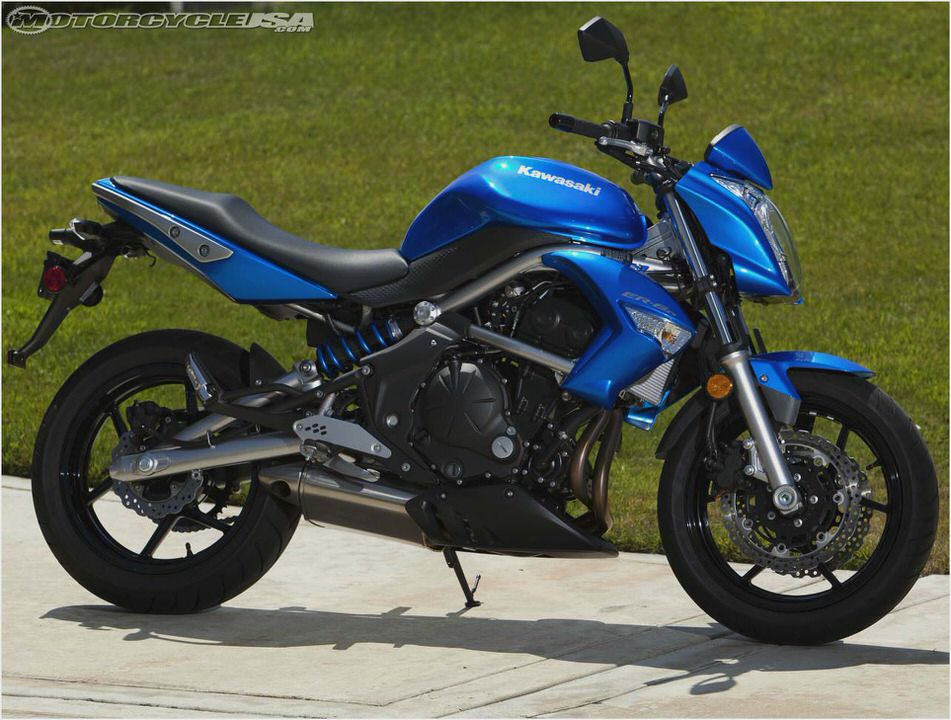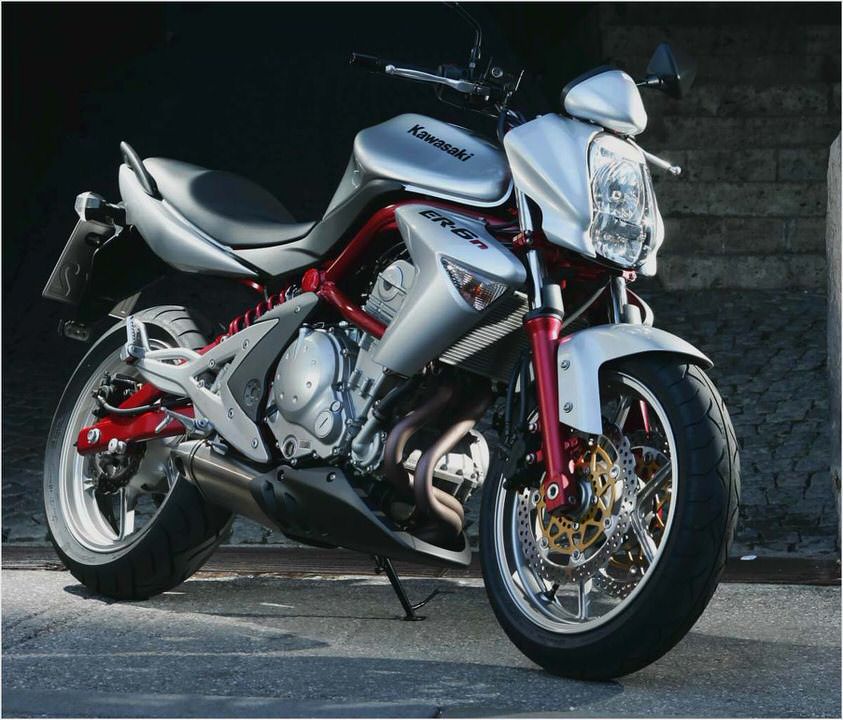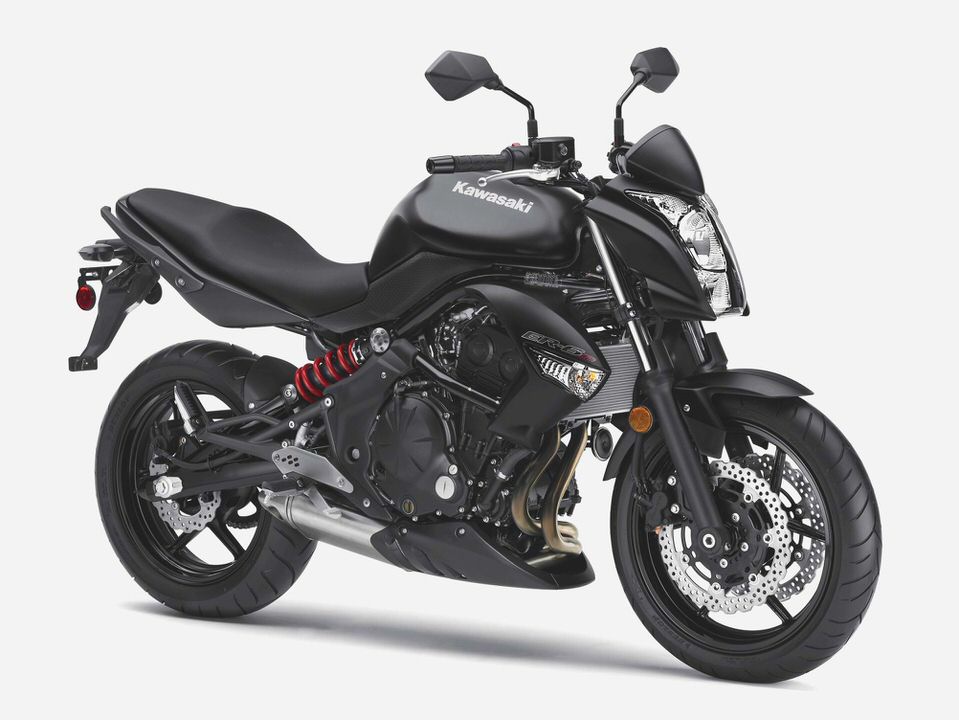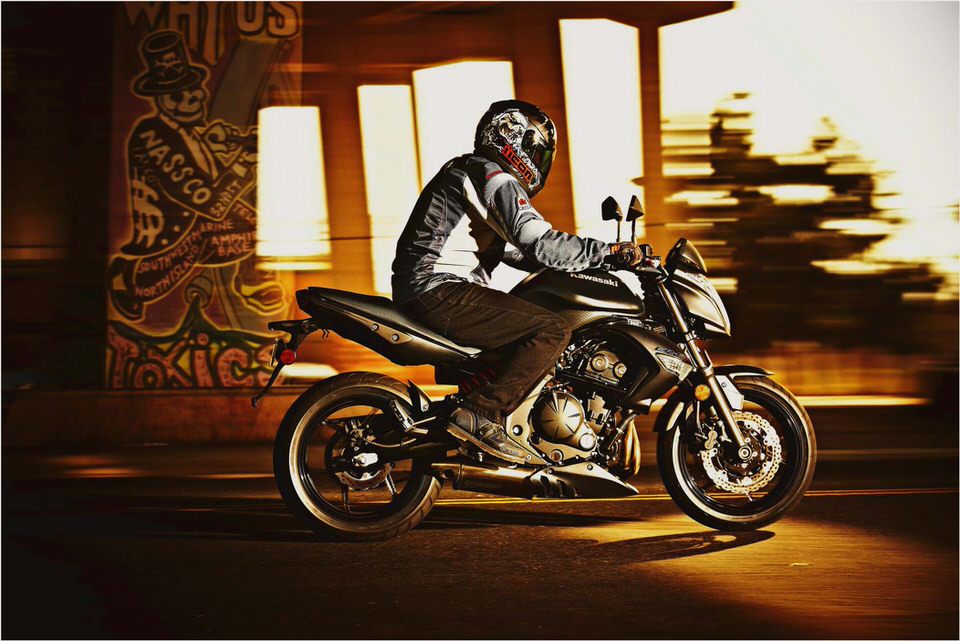
2009 Kawasaki ER-6n vs. 2009 Suzuki Gladius – Comparison Test Completing the Triple Play with a pair of all-around Twins.
Photography by Jeff Allen
All good things come in threes, right? Blondes, brunettes and redheads. Detroit’s Big Three (well, not so much these days). Tic Tac Toe. Ready, set, go! Yadda, yadda, yadda. Kawasaki and Suzuki…
Come again?
Think about it: two Twins, each engine powering a trio of entry-level machines targeting the popular sport, adventure and, now, naked market segments. While Kawasaki’s fully faired Ninja 650R and stilt-legged Versys have been available stateside for some time, the stripped ER-6n is brand-new to the U.S. this year. Ditto Suzuki’s Gladius, a gussied-up, bare-it-all spin-off of the trackday-friendly SV650SF and go-anywhere V-Strom 650.
Stripped to their essentials, the ER-6n and the Gladius are practically, uh, twins. Both employ steel frames and swingarms. Both are fitted with conventional 41mm forks and spring-preload-adjustable monoshocks.
Both feature tubular handlebars, low-slung seats, rubber-covered footpegs and beefy passenger grab handles. Both come with disc brakes at each end pinched by twin-piston, pin-slide calipers up front and single-piston stoppers at the rear. Wheel and tire sizes—17-inch cast aluminum hoops shod with 120/70 front and 160/60 rear radial rubber—are identical, too.
Same goes for claimed seat heights—30.9 inches. It is as though each factory knew exactly what the other was building.
With one all-important exception: engine architecture. While the 649cc ER-6n pairs its blacked-out cylinders side-by-side, the 645cc Gladius splays its battleship-gray barrels 90 degrees apart. The rest of the spec sheet is pretty much state-of-the-art Modern Japanese Motorcycle: liquid-cooling, double overhead camshafts, four valves per cylinder, electronic fuel-injection, six-speed transmissions and cable-actuated clutches.
When it debuted in 1999, the SV650 was an instant success. Retailing for $5699, that original carbureted model was part commuter, part sportbike and all bargain. The midsize Suzuki even scored an Honorable Mention in CW ‘s annual Ten Best balloting—no faint praise.
For use in the Gladius, the latest version of this now-decade-old V-Twin received a number of model-specific updates—intake and exhaust tweaks, higher-lift camshafts, a heavier flywheel and a redesigned clutch mechanism. An automatic Idle Speed Control (ISC) integrated into each 39mm throttle body is said to stabilize engine revs at start-up and reduce emissions. An oval throttle pulley softens low-end-to-midrange power delivery.
The result is an even more user-friendly package, making 68 horsepower at 8450 rpm and 49 foot-pounds of torque at 7500 rpm on the CW dynamometer.
We first came to know Kawasaki’s semi-dry-sump parallel-Twin with its modern vertically stacked transmission shafts in the 2006 Ninja 650R—called the ER-6f in Europe. The ER-6n debuted at the same time, but its sale was for the past three years limited to overseas markets. Now, the 6n is available on these shores.
While the 650R and the Versys use the same 180-degree firing order, tuning is different. The last Versys we tested made peak horsepower (59 hp) and torque (42 ft.-lb.) a full 1000 rpm lower in the rev range—at 7600 and 6225 rpm, respectively—than the 650R. The ER-6n, meanwhile, is Ninja-spec all the way: 62 hp at 8680 rpm and 43 ft.-lb. of torque at 7340 rpm.
More powerful, yes, but still down 9 and 12 percent to the Gladius.
Imagine our surprise, then, when the admittedly 4-pound-lighter Kawasaki was a little quicker than the Suzuki both from 0–60 mph (3.5 vs. 3.6 seconds) and through the quarter-mile (11.8 seconds at 110 mph vs. 12.1 at 105). “Both of these bikes get off the line really well,” noted Road Test Editor Don Canet. The ER-6n also has a slightly higher top speed than the Gladius: 123 vs.
121 mph. The Suzuki did win the fuel-economy battle, delivering a multiple-tank average of 51 mpg; the Kawasaki mustered “only” 41 mpg.
Testers had mixed opinions about these two engines. Some found the naturally at-ease Suzuki Vee motor smoother and less “busy” at speed. Others argued for the Kawasaki with its rubber upper-rear engine mount and counterbalancer.

Everyone agreed the Gladius makes great noises; the Kawasaki feels and sounds as though it is working harder, even when turning identical revs.
Regardless, both bikes are innately approachable and easy to ride, with light-effort controls, span-adjustable levers and wide-set, usefully large rearview mirrors. The Kawasaki has a nearly 2-inch-shorter wheelbase, which should make it more nimble. But, even with preload jacked up, it sits low in the back, and steering suffers.
Stepping off the ER-6n after bombing recently repaved Ortega Highway, Associate Editor Mark Cernicky remarked that he couldn’t remember the last time he’d ridden a motorcycle that required so much handlebar input to hold a line through a corner. “I can’t even do a stoppie,” added our resident stunter. “The front tire just locks up and slides. Great wheelies, though.”
About those brakes: The Kawasaki is fitted with 300mm petal-style front discs; the Suzuki wears conventional 290mm floaters. Yet the Gladius has better feel and stops harder with less rider effort. Quick stops from speed on the ER-6n require an especially firm squeeze on the dead-feeling lever.
Ergonomics are conceptually the same—medium-height handlebar, slightly dished seat, mildly rearset footpegs—but the Gladius is more spacious. Staffers short or tall, big or small, felt instantly at home on it. Okay, the handlebar has a tad too much rearward sweep for the sportiest among us, forcing the rider to pull himself into the wind at freeway speeds, but swapping it for one with a different bend would only take a few minutes.
The ER-6n presents a different scenario, its narrower bar (with 2 fewer inches of rise) and higher-set footpegs making for a sportier albeit somewhat cramped cockpit. Also, while both saddles are on the thin side—flat-footing at stoplights having gotten the nod over all-day comfort—the Kawasaki’s has a nicer shape with fewer sharp edges. Suzuki’s accessories division offers a more amply padded, 3/4-inch-taller seat ($170).
We tried it, and if you’re taller than 5-foot-10, don’t leave the dealership without it.
Appearances count, too, especially when emptying your own bank account. All agreed that the Kawasaki is the Angelina Jolie of bargain bikes, especially from down low, where the golden-hued twin exhaust pipes can be seen snaking their way back to the shapely muffler. “I’m drawn to the ER-6n,” mused Contributing Editor John Burns. For Senior Editor Paul Dean, the 6n wins by default. “I hate the Gladius’ styling,” he said.
I’ll admit it: I’m torn between these two machines. The Kawasaki is a terrific-looking motorcycle and a kick to ride. On the flip side, the Gladius’s organic silhouette has its admirers, too. What truly sets the Suzuki apart from the Kawasaki, though, is its great little V-Twin.
You simply can’t go wrong with that engine, no matter how Suzuki packages it.




- First Impression: 1996 Kawasaki Eliminator 600 Motortrend
- Bike Reviews – Kawasaki ER-6n PRLog
- Kawasaki Insurance – Motorbike Insurance for Kawasaki Bennetts
- 2005 Kawasaki Z 750S –
- Kawasaki Ninja 400 R Description SportsMafia

